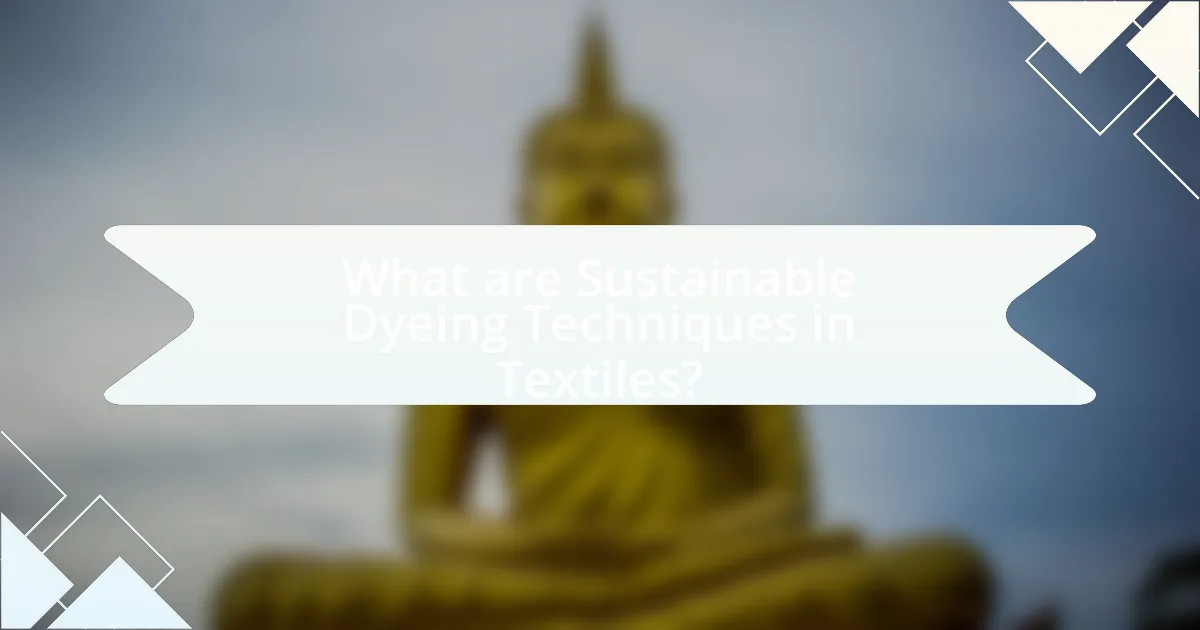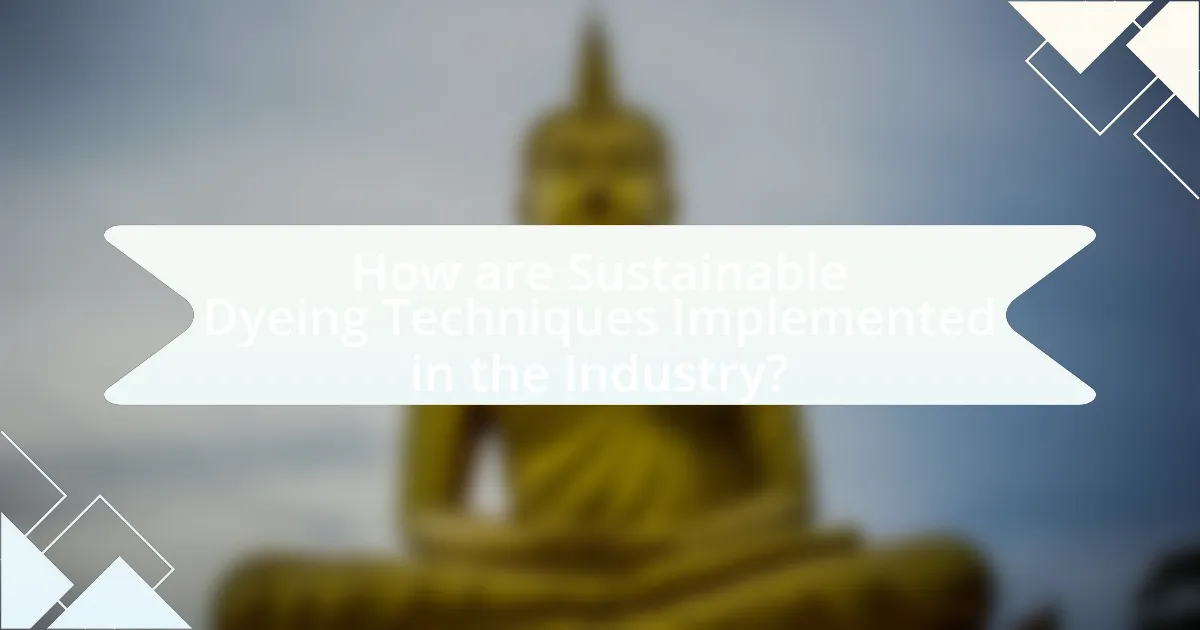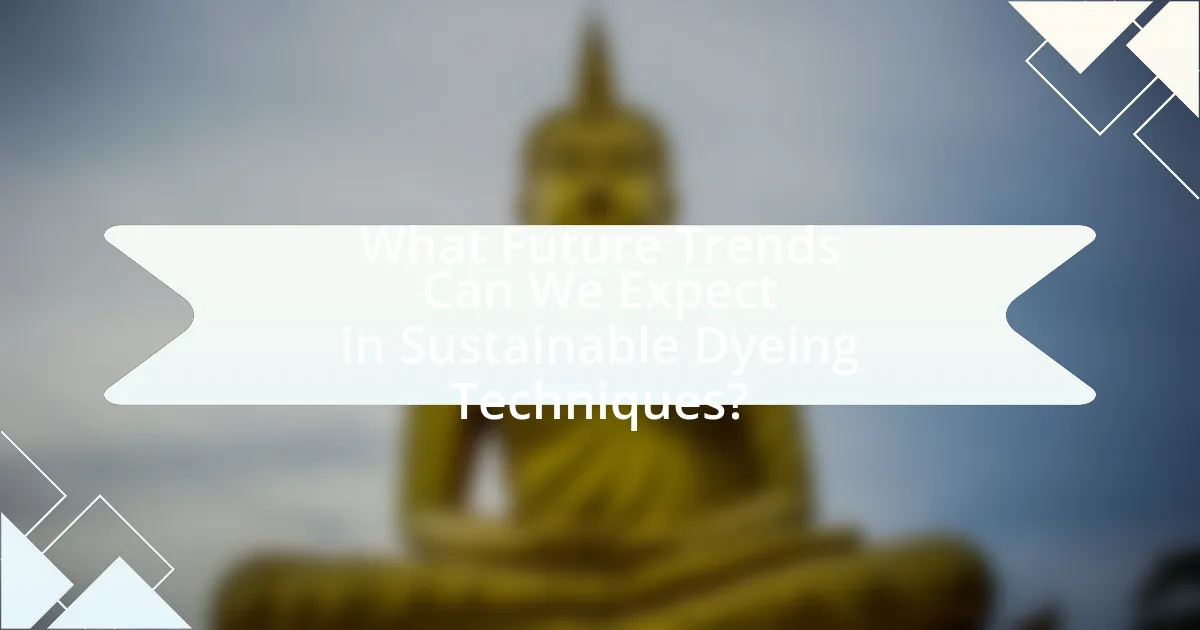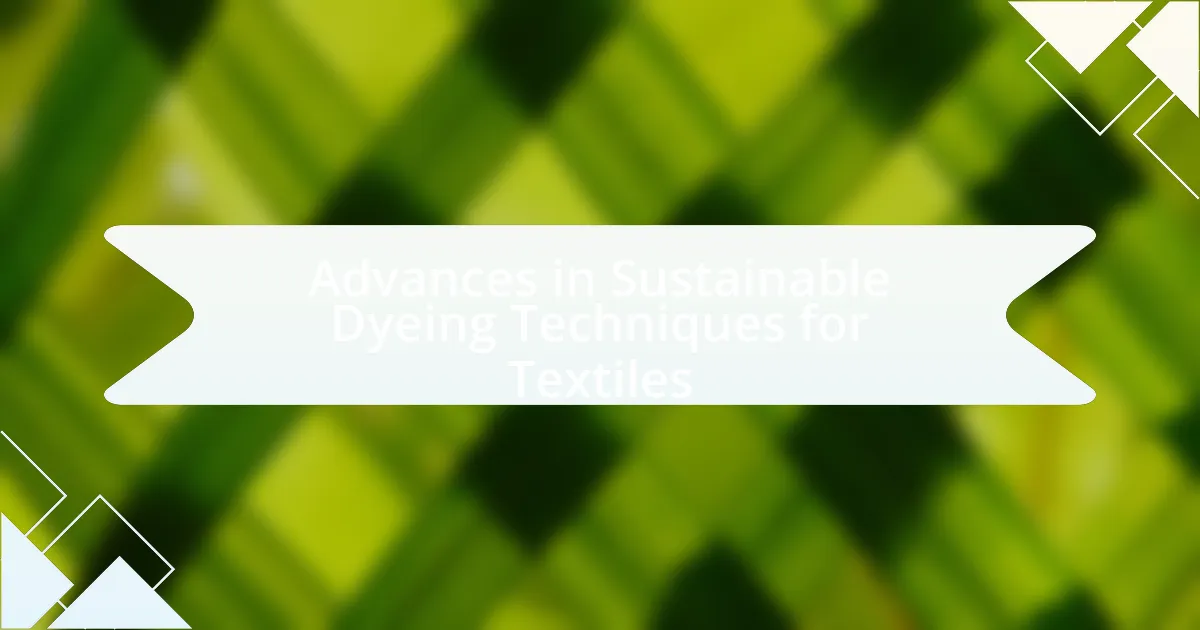The article focuses on advances in sustainable dyeing techniques for textiles, highlighting methods that minimize environmental impact while achieving color on fabrics. It covers various sustainable practices, including natural dyeing, low-impact synthetic dyes, and innovative technologies such as digital printing and waterless dyeing processes. The discussion emphasizes the differences between sustainable and traditional dyeing methods, the environmental benefits of adopting sustainable practices, and the challenges faced by the industry. Additionally, it explores the role of technology, consumer preferences, and regulatory frameworks in shaping the future of sustainable dyeing, along with best practices for implementation and measurement of impact.

What are Sustainable Dyeing Techniques in Textiles?
Sustainable dyeing techniques in textiles refer to methods that minimize environmental impact while achieving color on fabrics. These techniques include natural dyeing, which uses plant-based or mineral sources, and low-impact synthetic dyes that reduce water and energy consumption. For instance, natural dyes derived from indigo or madder root are biodegradable and non-toxic, contrasting with conventional synthetic dyes that often contain harmful chemicals. Additionally, techniques such as digital printing and waterless dyeing processes, like supercritical CO2 dyeing, significantly decrease water usage and pollution. Research indicates that adopting these sustainable practices can reduce the textile industry’s water footprint by up to 90%, highlighting their effectiveness in promoting environmental sustainability.
How do sustainable dyeing techniques differ from traditional methods?
Sustainable dyeing techniques differ from traditional methods primarily by utilizing eco-friendly materials and processes that minimize environmental impact. Traditional dyeing often relies on synthetic dyes and harmful chemicals, which can pollute water sources and harm ecosystems. In contrast, sustainable methods employ natural dyes derived from plants, minerals, or other renewable resources, significantly reducing toxicity. For example, a study published in the Journal of Cleaner Production highlights that natural dyes can reduce water pollution by up to 80% compared to synthetic dyes. Additionally, sustainable dyeing techniques often incorporate water-saving technologies and energy-efficient processes, further distinguishing them from conventional practices that typically consume large amounts of water and energy.
What environmental impacts are reduced by sustainable dyeing techniques?
Sustainable dyeing techniques significantly reduce water pollution, chemical waste, and energy consumption. Traditional dyeing processes often release harmful chemicals and dyes into water bodies, leading to ecological damage and health risks. In contrast, sustainable methods utilize natural dyes, closed-loop systems, and less harmful chemicals, minimizing toxic runoff. For instance, the use of plant-based dyes can decrease the reliance on synthetic dyes, which are often petroleum-based and contribute to environmental degradation. Additionally, sustainable practices can lower energy usage by employing lower temperature processes and renewable energy sources, thereby reducing the carbon footprint associated with textile production.
How do sustainable techniques contribute to resource conservation?
Sustainable techniques contribute to resource conservation by minimizing waste and reducing the consumption of water, energy, and raw materials in textile dyeing processes. For instance, methods such as digital printing and the use of natural dyes significantly lower water usage compared to traditional dyeing methods, which can consume up to 100 liters of water per kilogram of fabric. Additionally, sustainable practices often incorporate recycling and upcycling of materials, further decreasing the demand for virgin resources. Research indicates that implementing these techniques can reduce energy consumption by up to 30%, thereby conserving fossil fuels and lowering greenhouse gas emissions.
What innovations are driving advances in sustainable dyeing?
Innovations driving advances in sustainable dyeing include the development of waterless dyeing technologies, bio-based dyes, and digital printing techniques. Waterless dyeing methods, such as supercritical CO2 dyeing, significantly reduce water usage and eliminate harmful wastewater. Bio-based dyes, derived from natural sources like plants and microorganisms, offer a non-toxic alternative to synthetic dyes, reducing environmental impact. Digital printing techniques minimize dye waste and allow for on-demand production, further enhancing sustainability in textile dyeing processes. These innovations collectively contribute to a more eco-friendly approach in the textile industry.
What role do natural dyes play in sustainable dyeing advancements?
Natural dyes play a crucial role in sustainable dyeing advancements by providing eco-friendly alternatives to synthetic dyes, which often contain harmful chemicals. These natural dyes, derived from plants, minerals, and insects, reduce environmental impact through biodegradable properties and lower toxicity levels. For instance, studies have shown that natural dyes can significantly decrease water pollution and energy consumption during the dyeing process compared to conventional methods. Additionally, the use of natural dyes supports biodiversity and promotes sustainable agricultural practices, as many dye sources are cultivated in a manner that enhances soil health and reduces reliance on synthetic fertilizers.
How is technology enhancing sustainable dyeing processes?
Technology is enhancing sustainable dyeing processes by introducing innovative methods that reduce water usage, energy consumption, and harmful chemical emissions. For instance, digital printing technology allows for precise application of dyes, minimizing waste and enabling the use of eco-friendly inks. Additionally, advancements in dyeing machinery, such as closed-loop systems, recycle water and chemicals, significantly lowering environmental impact. Research from the Journal of Cleaner Production indicates that these technologies can reduce water consumption by up to 90% compared to traditional dyeing methods. Furthermore, the integration of artificial intelligence in dye formulation optimizes color matching and reduces the need for toxic substances, promoting a more sustainable textile industry.
What challenges do sustainable dyeing techniques face?
Sustainable dyeing techniques face several challenges, including high production costs, limited availability of eco-friendly materials, and the need for specialized knowledge and technology. High production costs arise from the use of natural dyes and sustainable processes, which can be more expensive than conventional methods. Limited availability of eco-friendly materials restricts the options for manufacturers, making it difficult to scale sustainable practices. Additionally, the need for specialized knowledge and technology can hinder widespread adoption, as many textile producers may lack the expertise required to implement these techniques effectively.
What are the economic barriers to adopting sustainable dyeing methods?
The economic barriers to adopting sustainable dyeing methods include high initial investment costs, limited access to sustainable materials, and the need for specialized equipment. High initial investment costs deter many manufacturers from transitioning to sustainable practices, as they often require significant capital for new technologies and processes. Limited access to sustainable materials, which can be more expensive than conventional options, further complicates the adoption of these methods. Additionally, the need for specialized equipment and training can increase operational costs, making it challenging for smaller businesses to compete with larger, established companies that may not prioritize sustainability.
How do regulatory frameworks impact sustainable dyeing practices?
Regulatory frameworks significantly influence sustainable dyeing practices by establishing standards that promote environmentally friendly methods and materials. These regulations often mandate the reduction of harmful chemicals and waste in dyeing processes, compelling manufacturers to adopt greener technologies. For instance, the European Union’s REACH regulation restricts the use of hazardous substances in textiles, pushing companies towards sustainable alternatives. Compliance with such regulations not only enhances environmental protection but also encourages innovation in dyeing techniques, leading to the development of biodegradable dyes and water-efficient processes.

How are Sustainable Dyeing Techniques Implemented in the Industry?
Sustainable dyeing techniques are implemented in the industry through the adoption of eco-friendly materials, innovative processes, and waste reduction strategies. For instance, many textile manufacturers now utilize natural dyes derived from plants, minerals, and insects, which significantly reduce the environmental impact compared to synthetic dyes. Additionally, technologies such as digital printing and waterless dyeing methods, like supercritical CO2 dyeing, minimize water usage and chemical waste. According to a report by the Ellen MacArthur Foundation, transitioning to sustainable dyeing practices can reduce water consumption by up to 90% and lower carbon emissions significantly. These practices are increasingly being adopted by major brands to meet consumer demand for environmentally responsible products and comply with stricter regulations on chemical use in textiles.
What industries are leading the way in sustainable dyeing practices?
The textile industry is leading the way in sustainable dyeing practices. This sector is increasingly adopting eco-friendly methods such as natural dyes, waterless dyeing technologies, and digital printing techniques. For instance, companies like Adidas and Patagonia have implemented waterless dyeing processes that significantly reduce water consumption and chemical usage. Additionally, the fashion industry is moving towards using organic and biodegradable dyes, which are less harmful to the environment. According to a report by the Ellen MacArthur Foundation, the textile industry is responsible for 20% of global wastewater, highlighting the urgent need for sustainable practices.
How are fashion brands integrating sustainable dyeing into their production?
Fashion brands are integrating sustainable dyeing into their production by adopting eco-friendly materials and innovative techniques that minimize environmental impact. For instance, brands are increasingly using natural dyes derived from plants, minerals, and insects, which reduce reliance on synthetic chemicals that can harm ecosystems. Additionally, some companies are implementing waterless dyeing technologies, such as digital printing and air dyeing, which significantly decrease water usage and pollution. A notable example is the use of the AirDye process, which utilizes air instead of water, resulting in a 90% reduction in water consumption compared to traditional dyeing methods. These practices not only enhance sustainability but also align with consumer demand for environmentally responsible products.
What role do consumers play in promoting sustainable dyeing techniques?
Consumers play a crucial role in promoting sustainable dyeing techniques by driving demand for eco-friendly products. Their purchasing choices influence manufacturers to adopt sustainable practices, as seen in the growing market for organic and low-impact dyes, which has increased by 20% annually over the past five years. Additionally, consumers’ awareness and advocacy for environmental issues encourage brands to invest in sustainable technologies and transparency in their supply chains. This shift not only supports the development of innovative dyeing methods but also fosters a culture of sustainability within the textile industry.
What are the best practices for implementing sustainable dyeing techniques?
The best practices for implementing sustainable dyeing techniques include using natural dyes, reducing water consumption, and minimizing chemical usage. Natural dyes, derived from plants, minerals, or insects, significantly lower environmental impact compared to synthetic dyes, which often contain harmful chemicals. Reducing water consumption can be achieved through techniques such as dyeing with less water or using waterless dyeing technologies, which can decrease water usage by up to 90%. Additionally, minimizing chemical usage involves selecting non-toxic, biodegradable chemicals and employing processes that reduce or eliminate harmful substances, thereby protecting both the environment and human health. These practices not only enhance sustainability but also align with growing consumer demand for eco-friendly products.
How can manufacturers optimize their dyeing processes for sustainability?
Manufacturers can optimize their dyeing processes for sustainability by adopting waterless dyeing technologies, such as supercritical CO2 dyeing, which significantly reduces water usage and eliminates harmful wastewater. This method not only conserves water but also minimizes the environmental impact associated with traditional dyeing processes, which can consume up to 100 liters of water per kilogram of fabric dyed. Additionally, manufacturers can implement the use of natural dyes derived from renewable resources, which reduces reliance on synthetic chemicals and lowers the carbon footprint. Studies have shown that integrating these sustainable practices can lead to a reduction in energy consumption by up to 50% and a decrease in chemical waste, thereby enhancing the overall sustainability of textile production.
What partnerships can enhance the effectiveness of sustainable dyeing initiatives?
Collaborations between textile manufacturers, dye suppliers, and environmental organizations can significantly enhance the effectiveness of sustainable dyeing initiatives. These partnerships facilitate the sharing of innovative dyeing technologies and sustainable practices, leading to reduced water usage and lower chemical waste. For instance, partnerships with research institutions can drive the development of eco-friendly dyes, while collaborations with NGOs can promote awareness and compliance with environmental standards. Such alliances have been shown to improve resource efficiency and reduce the overall environmental impact of dyeing processes, as evidenced by case studies highlighting successful joint ventures in sustainable textile production.

What Future Trends Can We Expect in Sustainable Dyeing Techniques?
Future trends in sustainable dyeing techniques will likely focus on biobased dyes, waterless dyeing technologies, and circular economy practices. Biobased dyes, derived from natural sources such as plants and microorganisms, are gaining traction due to their lower environmental impact compared to synthetic dyes. Waterless dyeing technologies, such as supercritical CO2 dyeing, are being developed to significantly reduce water usage, which is critical given that the textile industry is one of the largest consumers of water globally. Additionally, circular economy practices, which emphasize recycling and reusing materials, are expected to become more prevalent, as brands seek to minimize waste and promote sustainability. These trends are supported by industry reports indicating a growing demand for eco-friendly practices among consumers and regulatory pressures for sustainable production methods.
How will advancements in technology shape the future of sustainable dyeing?
Advancements in technology will significantly enhance the future of sustainable dyeing by introducing more efficient, eco-friendly processes and materials. Innovations such as digital printing and bio-based dyes reduce water consumption and chemical waste, addressing environmental concerns associated with traditional dyeing methods. For instance, digital textile printing can use up to 90% less water compared to conventional techniques, as reported by the World Bank. Additionally, the development of algae-based dyes offers a renewable alternative that minimizes reliance on petroleum-based products, further promoting sustainability in the textile industry. These technological advancements not only improve the ecological footprint of dyeing processes but also align with consumer demand for environmentally responsible products.
What innovations are on the horizon for eco-friendly dyeing materials?
Innovations on the horizon for eco-friendly dyeing materials include the development of bio-based dyes derived from natural sources such as plants, fungi, and bacteria. These materials are gaining traction due to their reduced environmental impact compared to synthetic dyes, which often contain harmful chemicals. For instance, research has shown that using indigo dye extracted from the plant Indigofera tinctoria can significantly lower water pollution levels associated with traditional dyeing processes. Additionally, advancements in digital printing technology allow for precise dye application, minimizing waste and energy consumption. These innovations are supported by a growing demand for sustainable practices in the textile industry, as evidenced by the increasing number of brands adopting eco-friendly dyeing methods.
How might consumer preferences influence future sustainable dyeing practices?
Consumer preferences will significantly influence future sustainable dyeing practices by driving demand for eco-friendly materials and processes. As consumers increasingly prioritize sustainability, brands will be compelled to adopt innovative dyeing techniques that minimize environmental impact, such as using natural dyes or waterless dyeing technologies. Research indicates that 66% of global consumers are willing to pay more for sustainable brands, highlighting the market potential for companies that align with these preferences. This shift not only encourages the development of sustainable practices but also fosters transparency in supply chains, as consumers seek information about the environmental footprint of their purchases.
What practical steps can businesses take to adopt sustainable dyeing techniques?
Businesses can adopt sustainable dyeing techniques by implementing water-efficient dyeing processes, utilizing natural dyes, and investing in eco-friendly technologies. Water-efficient processes, such as digital printing and air dyeing, significantly reduce water consumption, with some methods using up to 90% less water than traditional dyeing. The use of natural dyes, derived from plants and minerals, minimizes environmental impact and reduces reliance on synthetic chemicals, which can be harmful. Additionally, investing in eco-friendly technologies, such as closed-loop systems that recycle water and chemicals, can further enhance sustainability. These steps not only contribute to environmental conservation but also align with consumer demand for sustainable practices in the textile industry.
What resources are available for companies looking to transition to sustainable dyeing?
Companies looking to transition to sustainable dyeing can access various resources, including industry guidelines, research publications, and partnerships with sustainable dye suppliers. The Sustainable Apparel Coalition provides tools like the Higg Index, which helps companies assess their environmental impact and improve sustainability practices. Additionally, organizations such as the Textile Exchange offer resources and certifications for sustainable materials and practices. Research studies, such as those published in the Journal of Cleaner Production, provide insights into innovative dyeing techniques that reduce water and chemical usage. Collaborating with academic institutions can also yield valuable knowledge on sustainable practices and technologies.
How can businesses measure the impact of their sustainable dyeing efforts?
Businesses can measure the impact of their sustainable dyeing efforts through metrics such as water usage reduction, energy consumption, and chemical waste minimization. By implementing life cycle assessments (LCAs), companies can quantify the environmental benefits of sustainable dyeing processes compared to traditional methods. For instance, a study by the Textile Exchange reported that sustainable dyeing techniques can reduce water usage by up to 90% and energy consumption by 30%. Additionally, businesses can track customer feedback and market trends to assess the economic impact of their sustainable practices, as consumers increasingly prefer eco-friendly products.

Leave a Reply